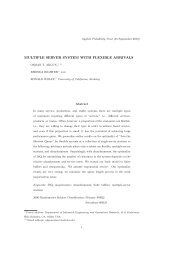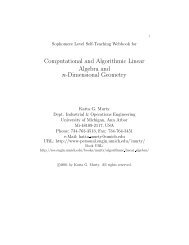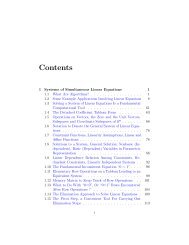Chapter 1 LINEAR COMPLEMENTARITY PROBLEM, ITS ...
Chapter 1 LINEAR COMPLEMENTARITY PROBLEM, ITS ...
Chapter 1 LINEAR COMPLEMENTARITY PROBLEM, ITS ...
You also want an ePaper? Increase the reach of your titles
YUMPU automatically turns print PDFs into web optimized ePapers that Google loves.
42 <strong>Chapter</strong> 1. Linear Complementarity Problem, Its Geometry, and Applications<br />
Since A, B are strictly positive matrices, x T Ay and x T By are strictly positivenumbers.<br />
Let = x=(x T By) and = y=(x T Ay). Introducing slack variables corresponding to<br />
the inequality constraints, (1.41) is equivalent to<br />
8<br />
9<br />
8<br />
>: u><br />
; >: 0 A<br />
v BT 0<br />
8<br />
>: u<br />
9 8<br />
> ><br />
v =<br />
0<br />
9<br />
> 8 >: 9 8<br />
> = >: ;em<br />
9<br />
><br />
;eN<br />
>: 9 8 9<br />
> ><br />
=<br />
0 > T 8<br />
>: 9 > =0:<br />
>: u<br />
v<br />
(1:42)<br />
Conversely, it can easily be shown that if (u v ) is a solution of the LCP (1.42) then<br />
an equilibrium pair of strategies for the original game is (x y) wherex = =( P i)and<br />
y = =( P j). Thus an equilibrium pair of strategies can be computed by solving the<br />
LCP (1.42).<br />
Example 1.9<br />
Consider the game in which the loss matrices are<br />
A 0 =<br />
8<br />
>:<br />
9<br />
1 1 0><br />
B<br />
0 1 1<br />
0 =<br />
8<br />
>:<br />
9<br />
;1 1 0><br />
:<br />
0 ;1 1<br />
Player I's strategy is a probability vector x = (x1x2) T and player II's strategy is a<br />
probability vector y = (y1y2y3) T . Add 1 to all the elements in A 0 and 2 to all the<br />
elements in B 0 , to make all the elements in the loss matrices strictly positive. This<br />
leads to<br />
A =<br />
8<br />
>:<br />
9<br />
2 2 1><br />
B =<br />
1 2 2<br />
The LCP corresponding to this game problem is<br />
Example 1.10<br />
2<br />
6<br />
4<br />
u1<br />
u2<br />
v1<br />
v2<br />
v3<br />
3<br />
7<br />
5 ;<br />
2<br />
6<br />
4<br />
0 0 2 2 1<br />
0 0 1 2 2<br />
1 2 0 0 0<br />
3 1 0 0 0<br />
2 3 0 0 0<br />
8<br />
>:<br />
3 2<br />
7<br />
6<br />
7<br />
6<br />
5<br />
6<br />
4<br />
9<br />
1 3 2><br />
:<br />
2 1 3<br />
1<br />
2<br />
1<br />
2<br />
3<br />
3<br />
7<br />
5 =<br />
2<br />
6<br />
4<br />
;1<br />
;1<br />
;1<br />
;1<br />
;1<br />
u v > = 0 and u1 1 = u2 2 = v1 1 = v2 2 = v3 3 =0:<br />
3<br />
7<br />
5<br />
(1:43)<br />
The Prisoner's Dilemma:<br />
Here is an illustration of a bimatrix game problem from [1.31]. Two well known<br />
criminals were caught. During plea bargaining their Judge urged them both to confess<br />
and plead guilty. He explained that if one of them confesses and the other does not,<br />
the one who confesses will be acquitted and the other one givenasentence of 10 years










